Reefmote Control: Aquatica Remote Release reviewed
When the folks at Aquatica contacted me and told me they had developed a new remote control that worked with virtually all of its housings, I begged them to let me give it a try. “Jean, let me be the Pacific guinea pig,” I begged. After promising not to bug him again until 2010 and buying Blake ringside tickets to a Habs game, they cheerfully relented.
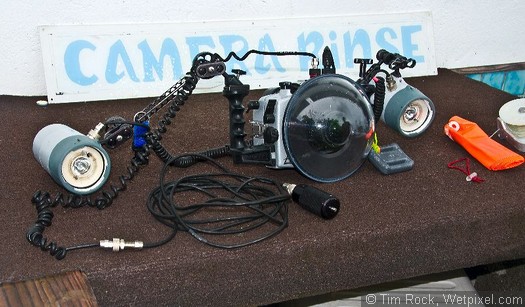
I have a Guam-based marine photo gallery and gift shop that’s part of an undersea observatory. Part of what we do is wild spinner dolphin tours three times daily. I thought I could rig a pole cam and get some great dolphin shots. That turned into a bit of a fiasco but every other thing I tried turned out great. Here’s all the news that’s fit to print.
The unit showed up just in time for my departure for Manta Mania in Yap! So I rigged it up. I then ambushed the wife a couple of times as she came into the house, strobes ablaze, to ensure it worked from distances great and small and then packed it up again and headed for Yap. I waved good-bye to her but she didn’t see me.
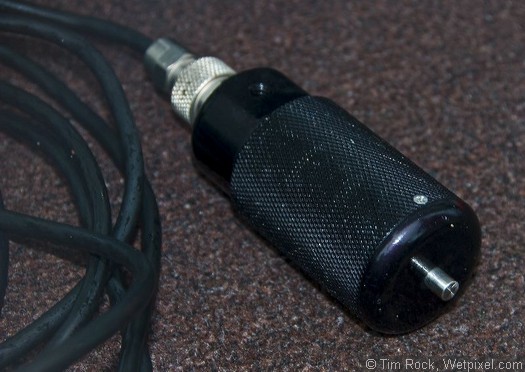
Upon arrival Bill Acker, the founder of Yap Divers and Manta Ray Bay Hotel, greeted me. He told me something to the effect that the boat leaves in a half hour! We would do a manta dive and then a shark feed! Yikes, baptism by fire.
I studiously assembled the unit and in what was closer to 45 minutes I managed to show at the dock and off we went across the broad aqua lagoon toward Gofnuw Channel. Bill and I discussed good spots for placement at the various cleaning stations found in Gofnuw. Each of about 5 sites has some areas of rock or dead coral where a unit could be placed, I could skitter away with a 20 foot cord and hide and wait for a manta to approach. So there I sat, hoping I had the right angle.
Now using a 10-17 Tokina zoom on my D200 inside the Aquatica housing with an 8” dome port turned out to be a pretty good selection. Except that the unit is pretty close to neutral and the dome actually made the camera point upwards or straight up. Note to self: Get a 2 lb. Weight from shop manager Jan Sledsens.
So after a bit of jockeying, I managed to get a crack at three different mantas. All were totally unprovoked by the fact that there was a housing sitting next to their favorite blue-stripe wrasse. I had the Ikelite DS125 strobes on 1/8 power just for fill and the exposure set for pretty much what I could get from the natural light 50 feet down. The channel is made of lots of white sand bottom and some big cabbage-type corals so its pretty reflective. The lens was set at 10mm on auto-focus.
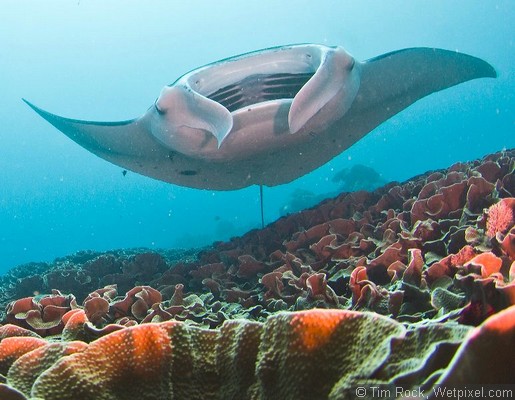
The first manta opened wide and I got one of those rare down-the-gullet cleaning shots that you rarely see, even when you aren’t in camera range. They normally aren’t that relaxed with someone around. It was totally relaxed and I was able to snap a half dozen frames before it went gliding past. As luck would have it, it actually following the strobe cord to my hiding place and went right over my head. Note to self: Bring a second camera for the occasional smart-ass manta belly shots.
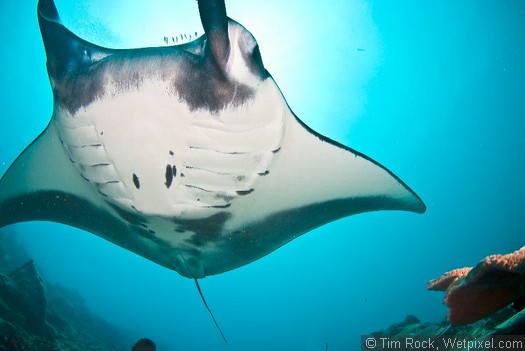
At another cleaning station, a beautiful female had a legion of tiny pilotfish riding the bow wave of its gaping mouth. This manta also soared right over the dome and I nailed it with the remote as well.
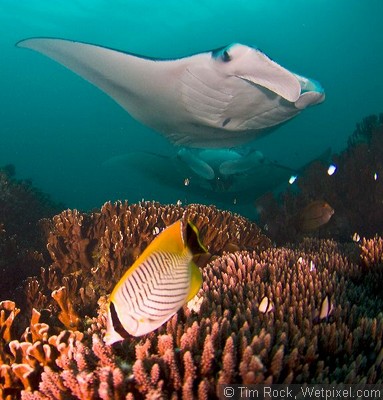
OK, so it seems to work well with slow, coasting mantas. Now, how would it do with frenzied reef sharks?
Yap Divers puts a small bait basket under a coral head just out of the reach of the curious reef sharks that live at the stunning Vertigo Reef. The reef isn’t that eye-popping really but the setting is. Vertigo slopes gently to about 50 feet and then takes a vertical plunge. Rocks and hard corals cover the top and everywhere the water is crystal clear. It ranges from a nice turquoise in the shallows to a deep cobalt blue in the depths. It is from this abyss the sharks rise.
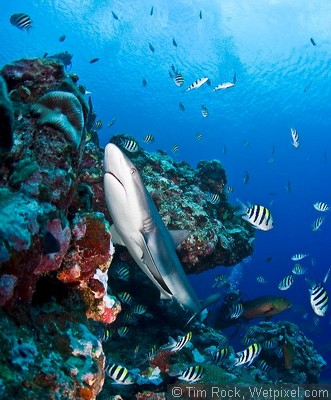
Now Bill had a new manager with him named Andrew Sweeney. This new manager was also a student of Bill’s and this dive would be his fourth open water dive. Andrew loved diving but was quite fearful of sharks. Thus, we decided to withold a bit of small (albeit) key information about this dive. It was going to be a shark feed!!!
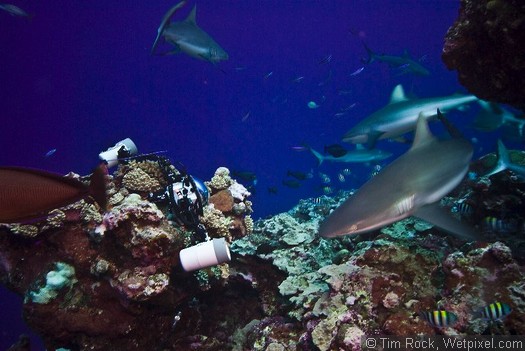
So it was all I could do to set up the remote as close to the bait basket as possible without laughing. As Andrew’s eyes stuck to his mask and his air stream was incredibly constant, I could see this was a dive for him like no other. Me too!
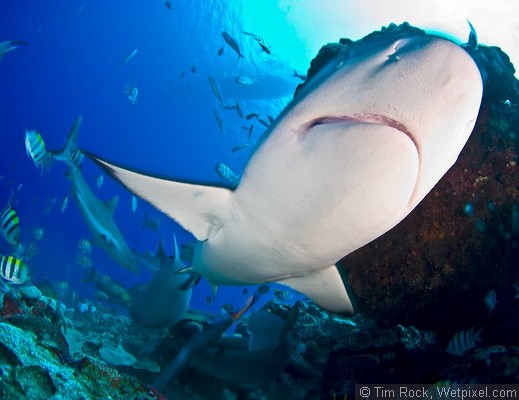
The sharks were getting bolder and bolder as they tried to get at the tuna heads inside the bait basket. The housing was sitting atop a coral rock quite near the bait but also quite near the dropoff. When a shark was unable to get at the bait, its interest would turn to my Aquatica. A couple rubbed their rough skins over the dome, another bit it and many came close. I fired away at will, capturing as many as four coming right at the dome at one time.

And to top it off, a giant grouper wandered up from the depths. This living ecosystem had a nose full of pilotfish, a following of rainbow runners and the respect of the wary sharks. But it didn’t quite get close enough for a photo op.
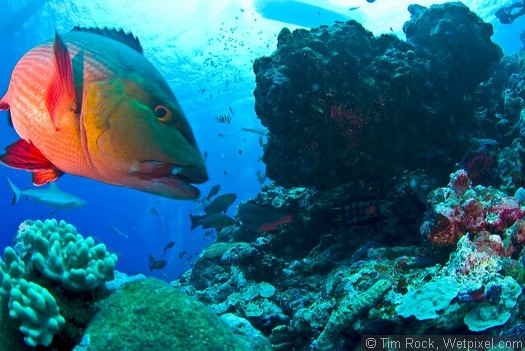
On the way back we reviewed the shots. The boatload of divers was impressed. Manta expert Andrea Marshall said she thought the remote gizmo should also be good for getting those hard to get macro shots like bulldozer shrimps and garden eels. Now, its one thing to remote focus on a two-ton manta with a 10mm fisheye lens. But to nail a reclusive shrimp or goby might be a stretch.
I wouldn’t know until I tried. So off I went to “Slow and Easy”, the diverse little macro bank in the Yap main channel. You can find lots of things here like sea moths, leaf fish and a gazillion types of nudibranchs. A good portion of the sandy slopes is home to sentinel gobies and bulldozer shrimp guarding their lairs.
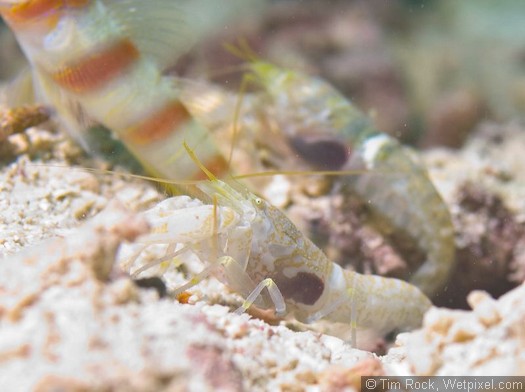
So I found a likely active hole and set up the camera, focused on the hole and took a couple of test shots. So far, so good. A moved far away but still close enough to see the action. After a while, out came the goby. A minute later the industrious bulldozer shrimps were piling rubble. It became obvious to me that I probably would not get the entire goby in the shot even with my 50mm Sigma Macro. But the bonus was since I was shooting from shrimp level, I would get a perspective on the bulldozer shrimp that you usually don’t get. To my amazement, some shots came out sharp as a tack and with a very pleasant new angle.
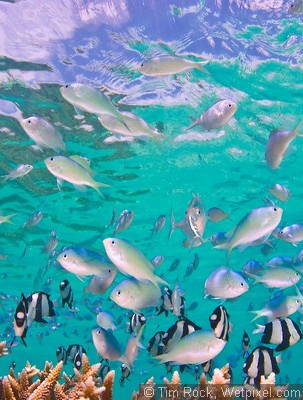
Back in Guam, I decided to try some close-focus medium perspective. In Guam’s Tumon Bay we have some nice anemone colonies and a profusion of light blue chromis. Here I set the D200 up with the 10-20 Sigma lens set at 20mm. So it was essentially a 28mm or so. I then backed off and let the chromis, damsels and other reef fish do their thing during a minus tide in the shallow bay. As they popped into the water column for food, I was able to many time fill the frame. Had I been nearer, they would have retreated into the confines of the staghorn and finger corals.
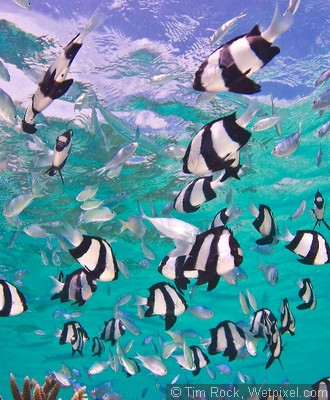
As you can see, the uses for this little gizmo are many and pretty much up to the creative spirit of the photographer. I did try to pole cam it in Guam as well. I have a business that is attached to a dolphin tours operation. On a good day, they come right up to the swimstep aft or hang at the bow. A trip to Home depot and I was in the Erector Set business.
Off I headed but I forgot it was June. In Guam, there are pilot whales and sometimes bottlenose schools and even whales around. This makes the poor spinners rather skittish and not much fun. The days I was able to go the sun hid and the wind kicked up. We tried a lot to get a decent pole came dolphin shot but the few that did turn out looked tiny or I just got bubble photos. Not to self: Forget this (at least until January).
But on scuba it was a snap. I rigged mine so that I could swim with it and use the camera normally to take advantage of anything I came across or that came across me. If a remote opportunity presented itself, like shooting a cleaning manta or even a shoal of goatfish at my deco stop, I could quickly uncoil the cord and snap away for three minutes.
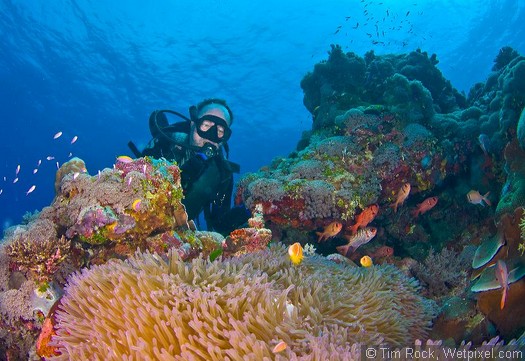
I am sure a much better planned use for this remote could also be created using a tripod and rebreathers, etc. It can go from being as simple or as complicated as the situation allows and dictates. It can also be used to safely take images where safety might be in question, like the shark feed extreme close-ups. So many uses, so little time. But I can highly recommend this being part of one’s arsenal. Its fun and the images are certainly different.
Note to self: Pack it for that next trip!
The Tech Stuff
The remote is pretty simple to use. Those who remember the Old Nikon RS remote will find this similar. On a D200 and on most of the new D Nikons, all of the connectors are located on the left side of the body (from the rear). On the front of the camera is the 10-pin remote terminal, on the side the Flash PC Sync terminal (normally protected by screw caps).
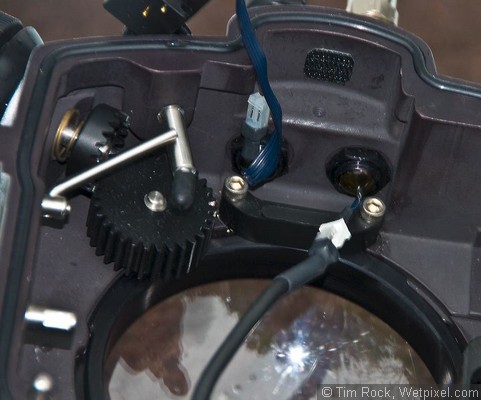
A dual bulkhead Aquatica housing lets you use a dual strobe set-up and the remote. All you do take a wire provide by Aquatica and run it from the 10-pin remote to the right housing terminal (as you look at the housing from the back). Then run the remote cord from the right bulkhead to the remote button. You can vary cord lengths according to the project. I had one that ran about 20 feet underwater. I used one of my Think Tank cable wraps to attach it to my TLC arm and that was about it.
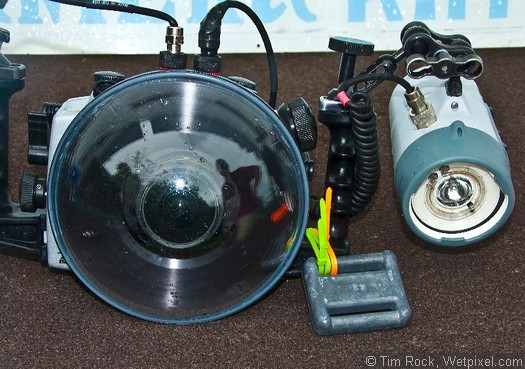
The strobe with a dual Ikelite cable runs out of the left bulkhead into dual DS 125s. I attached a 2 LB weight to the base of the housing to keep it from floating up due to the dome. It wasn’t art but it worked. We stayed in Yap for 10 diving days and I used the housing like this every day. There were no technical glitches, nothing hard or no high maintenance. It was pretty much a snap.
For more Information, contact Aquatica.